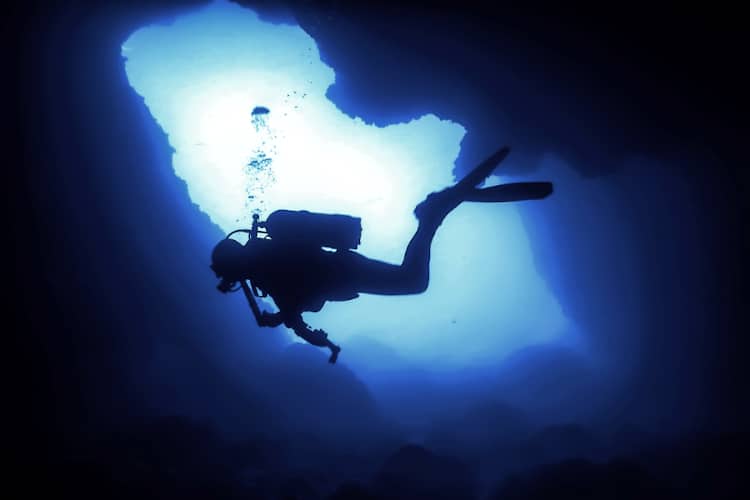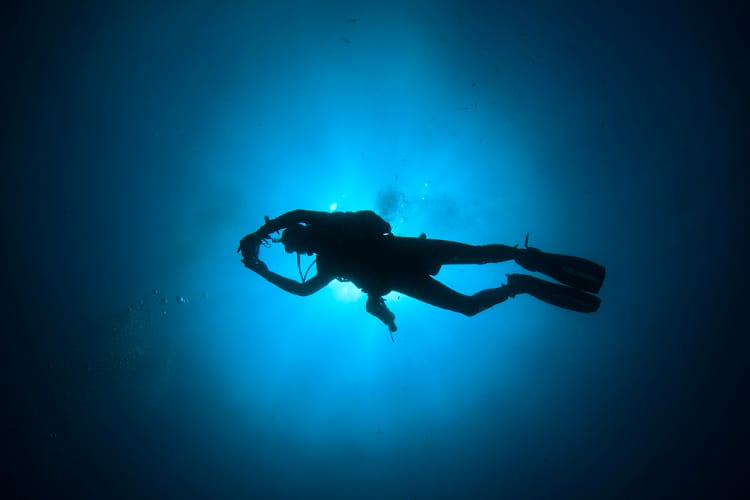
Photo: Allexxandar/Depositphotos (Not a photo of the actual diver.)
In March 2011, a devastating earthquake and tsunami struck Japan. The disaster took 19,759 lives, and as of August 2022, 2,553 people were still missing. One of them was a woman named Yuko Takamatsu, whose body was never recovered from the ocean. Hoping to bring her home, her husband, Yasuo Takamatsu took diving lessons at the age of 56 to try to find her. More than a decade later, the man has continued his search, having dived hundreds of times to look for his missing wife.
Looking for a body in the ocean is like looking for a needle in a haystack. Still, Takamatsu has not given up. “I expected it to be difficult,” the man told The New York Times, “and I’ve found it quite difficult, but it is the only thing I can do. I have no choice but to keep looking for her. I feel closest to her in the ocean.”
The couple met in 1988. She was 25, and was already an employee at the Onagawa branch of the 77 Bank where she would spend her final moments. He was a soldier in Japan’s Ground Self-Defense Force and his boss introduced them. Takamatsu remembers his wife as a gentle woman who listened to classical music and painted watercolors on canvases that she showed only to him.
The loving husband’s search for his beloved wife was inevitable, but he didn't start in the ocean. He first looked inland, at the bank where his wife worked. There he came across her cellphone with a sobering unsent message addressed to him that read: “so much tsunami.” After spending two years in the beaches, forests, and mountains, he knew there was only one answer left: the ocean. He learned how to dive from Masayoshi Takahashi, a local instructor who helped clean up debris from the tsunami. He joined Takamatsu on his dives, keeping records and maps.
On top of the vast area and depth of where they were looking, the ocean conditions make it far more complicated. “If a body is taken into the ocean and disappears, it’s hard to say what happens to it,” explains Tetsuya Takagi, a forensic pathologist at Tohoku Medical and Pharmaceutical University in Sendai. “No one ever really knows how the sea moves or flows. If a body is pulled down to a certain depth, it stays there. If it catches in fishing equipment, it might float across the Pacific and turn up in Hawaii. A body in the sea will mostly become soft as cheese so that if you touch it, the skin falls apart. In other cases the body may become encased in a substance called grave wax that makes it turn hard like plaster.”
Takamatsu's plight has moved filmmakers from around the world, who felt compelled to share this tale of undying love. Among them are directors Erik Shirai and Masako Tsumura, who produced the short film Nowhere to Go but Everywhere. Meanwhile, Anderson Wright directed a nine-minute film titled The Diver. While gutwrenching, these works of storytelling shine a light on the man's endurance, and how grief is just another expression of love.
Yasuo Takamatsu lost his wife, Yuko, to the devastating earthquake and tsunami struck Japan in 2011.

Photo: beloded.m.a./Depositphotos
Her body was never found, so at 56, he took diving lessons to look for her in the ocean.

Photo: PlanctonVideo/Depositphotos (Not the actual diver)
“I’ve found it quite difficult, but it is the only thing I can do. I have no choice but to keep looking for her. I feel closest to her in the ocean.”

Photo: richcarey/Depositphotos (Not the actual diver)
His fight has been documented in film, like the short documentary Nowhere to Go but Everywhere. Watch the trailer below.
h/t: [Good]
Related Articles:
Divers Discover Incredibly Rare Handfish While Exploring Sunken Ship
Divers Discover Nearly 50,000 Submerged Coins Off the Coast of Italy
Canadian Naval Divers Celebrate Graduation With an Underwater Class Photo
Whale Rescued by Divers Becomes a Tragic Lesson About the Realities of Illegal Drift Nets






















































































